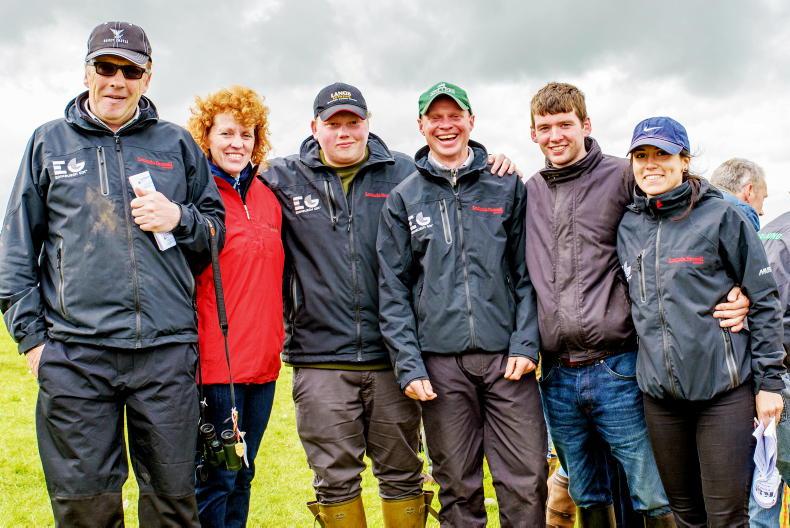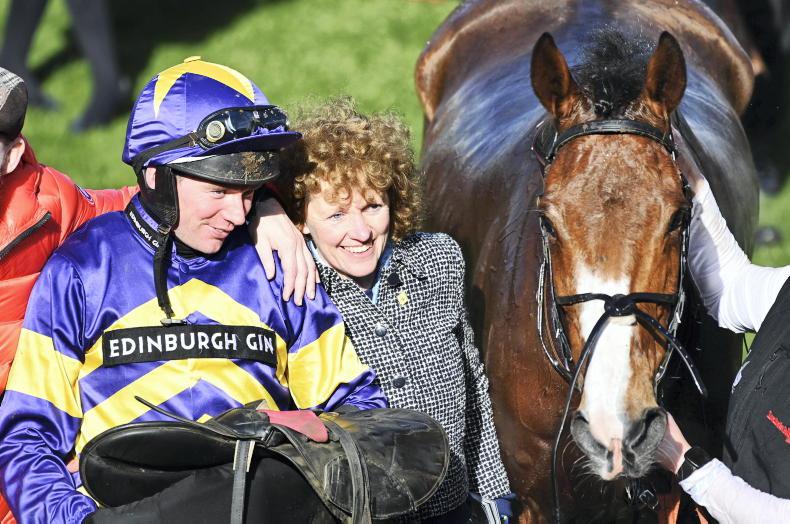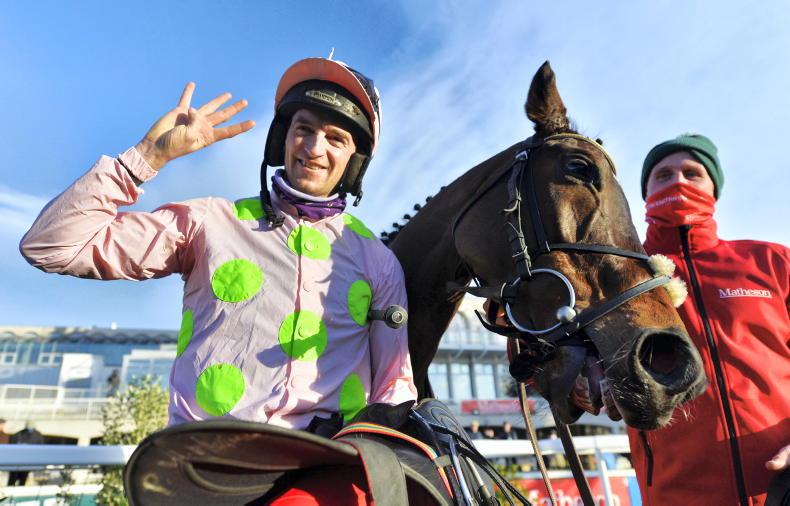HELEN Sharp (HS): Watching the horses on the gallops, can you describe the things you are looking for?
Lucinda Russell (LR): It’s funny, all my life I have found it easier to ride horses to find out how they are feeling rather than watch them. Scu (Peter Scudamore MBE - Russell’s partner, assistant trainer and former National Hunt Champion Jockey) and Blair Campbell, one of our assistant trainers, watch most of the horses on every gallop. I think they are obviously looking for how well the horses go against each other, we pair them up on a work day and see how they are coping against another horse of similar ability.
We have a good grass gallop here, I’m really happy riding horses up that and it just gives you a really good feel about the horse. We go round a circle at the bottom beside some white rails so you get to know how green they are, if they can hold themselves, and how balanced they are.
I suppose because we have worked here quite a long time, we know exactly the hill and know the dimensions and know the stayers will gallop all the way up to the very top. The quick horses will show a bit of speed. It’s actually hard to describe isn’t it, the feel of a horse that’s actually got an engine.
I rode one the other day called Serious Operator and when he goes up there, he’s very balanced and very lovely, covers the ground, copes with all the going. The grass gallops have soft bits and quick bits and as we got two furlongs from the top, I squeezed him to see if he would go on and suddenly you get this after-burn kicking in and you sort of know they have the power and the speed to be a decent horse.
It’s quite interesting, we’ll work horses alongside each other and we can rate them and have an idea even as a four-year-old. Really, it’s just feeling the power, feeling the balance, feeling the length of the stride, how easily they cover the ground.
HS: What has the greatest impact on maintaining soundness?
LR: This is a really good question, I am obsessed.
I suppose I started training in 1995 and in those days, you know, you would get good to firm ground, you would get good to firm in places. And it’s only nowadays we’ve learned that’s just criminal really - to run National Hunt horses on that sort of ground. The stress that it puts their tendons under is not great.
So, the biggest challenge we have to keep a horse sound is the going that they are getting raced on. At home we have many different types of gallops, we have woodchip, carpet, sand, grass. And we also work the horses around the farm so they are going up and down the hills, lots of different gradients for them. We are sort of conditioning the legs to cope with different going. The one thing I hate doing and won’t do is run horses on good to firm ground. I think it just increases the chance of injury.
We should definitely continue to help the racecourses invest in watering systems and machinery to keep the ground in the best condition they can. We certainly spend a lot of time, effort and money on keeping our gallops correct so that the horses don’t injure themselves during training. I think that’s a very important part of being a trainer nowadays, a very big part of our responsibility towards the horses.
HS: And building up stamina, do you go by numbers, by eye, by blows?
LR: A lot of our horses would be long distance horses and we are very proud of that. It’s certainly something we can put into our horses. We do it in the pre-training, we have a very set routine that every horse enters, seven weeks long and that brings them to being able to get up the gallops three or four times and start working.
It’s a routine that I absolutely stick to and I get quite stubborn about it, and every horse that comes into the yard will start off in this routine. We find it helps to maintain horses’ soundness and also to increase stamina. The stamina work we do is done in the early stages on a deep sand gallop, anyone in Ireland will be familiar with the deep sand gallops but they are something that’s quite new over here in Scotland.

Our rigid gallop that we have at the main yard is five furlongs long and it rises quite steadily and it also builds up the stamina a lot, the horses with good stamina can go up it four times, they work four times, twice a week. I think stamina is something that takes time to build, I don’t think you can do it very quickly and certainly as the horses get older they tend to increase that stamina.
Obviously we also put in a bit of speed training as well for them so we don’t have very, very slow horses. We also do a lot of work around the fields, up and down the hills, and so they are covering the miles and cantering over a long distance, that’s quite an old-fashioned thing to do really.
HS: Tell me about tricky horses, theones that aren’t sure if they want to be racehorses?
LR: We’ve got this theory - it’s like a herd mentality. If you put a naughty horse into a group of well-behaved horses they do tend to start behaving. We’ve had some real horrors in our time and horses who are really anxious about things, or are stubborn.
Obviously the first thing we would do is make sure there’s nothing physical that’s effecting them - I’m thinking about the nappy horse or the horse that swings around or the horse that takes off or bolts. I think with them a lot of the time it started with pain, that they’ve been asked to do something they can’t do at that stage in their development. So we’d probably take them back, get them checked over just to make sure that they are not in pain.
Once we have done that we are very lucky here, we’ve got a lot of jockeys that are very, very good riders, our standard of riding at this yard with the staff is excellent, very proud of that. And it means we can sort of pull on different people’s skills to sit on the naughty ones. We tend to find once they are into the routine here, they seem to like it and they seem to get on with it.
There are definitely some horses who don’t want to be racehorses. If horses are balking at workouts and throwing riders they probably just don’t want to be ridden. Once you get rid of the pain and the memory of it, it’s just about reassuring them and, in the old-fashioned way, keeping the leg on - just keeping them going forward. I think that’s quite important.
HS: Seeing One For Arthur looking wonderful at the Dublin Horse Show last year got me wondering what you feel trainers can do to help racehorses prepare for life after the track?
LR: I think the racehorse is very, very lucky you know, as soon as it’s born it’s worth money, as soon as it hits the ground there’s a professional person there looking after it and producing it and leading it and getting it ready for its career.
I’m very determined that every horse that enters this yard is able to not just gallop in a straight line, but has to be able to do it balanced and in the correct manner. The horses here walk up the road for a mile and a half to the gallops, so they are good in traffic. They get turned out every day, so they are good to catch.

I think things like the shoeing and stuff as I say, because they have been dealt with by professionals, they’ve never had that worry of not being dealt with correctly or getting a fright. I think we owe every horse an education whether it’s going to be a racehorse or not. To teach it to work out how to balance themselves and how to think for themselves, and how to enjoy being ridden.
HS: How do you get inside the head of a thoroughbred?
LR: It’s an interesting question - really it’s about feeling, I guess it’s experience too and it’s looking at the horse, noting what it likes. I always think if a horse doesn’t want to do something, quite often it starts off with pain stopping it and then that becomes a learnt behaviour.
I’ve always had thoroughbreds, even when I was eventing, it was always thoroughbreds. I think that’s because they are just a bit more sensitive and a bit more intelligent, sharp, quick to pick things up, it’s because in their mind they have to run to survive. It’s the fastest horse that doesn’t get eaten by the tiger.
I think whether it’s a thoroughbred or a Welsh Mountain Pony or a Clydesdale, it’s just about making that connection with the horse. I think it’s funny nowadays that a lot of people haven’t been brought up with horses - it’s a very urbanised population we are getting, as opposed to rural population. I think that’s a shame, I think people need to spend a bit of time with animals whether they are dogs, cats, horses, whatever. I suppose if you strip it back you know that horses are very good at pressure release and learning to trust you. I think Monty Roberts did a great thing teaching people about advanced retreat and getting horses to follow you and get into your space.
I just always want to be with horses and I think Scu knows if he ever doesn’t know where I am, I’m just in the stables with the horses. Just being with them, you know just little things.

I feed every morning and I think you can really tell by that how a horse is. Horses that are in pain, they’ll stop eating. Maybe just leave two nuts, three nuts however stoic they are, they often stop eating.
That’s something we can pick up on really quickly. It’s certainly something I set off my day with, I’ll feed at quarter to six and that’s probably the best part of my day, just spending time going around the horses.
You pick up on so many things, on just the way they move around the boxes, the way they are standing, whether they come to the door. I think the act of feeding is very, very important, always having in the back of your mind that they are exceptionally intelligent, we owe them so much.
Even the ones that are proper racehorses that love racing, they come in all different mentalities and some are very bolshy, some are brave, some are just quite calm, and just know they are better than other horses. I think it’s up to us as trainers to work out which horse has which personality and the best way to deal with it after that.
I think you have to be aware that individual horses have to have a little bit of individual attention. But how do you get inside their head? You just spend time with them, it’s the most important thing. I keep trying to drum that home to everyone - to look at the horse - that’s all you have to do, it’s very simple, just look at the horse. You can tell so much from it, from its demeanour, from the condition of it, from its behaviour. I think the horse tells you.
HS: Do you believe there is such a thing as a winning mentality in a champion racehorse?
LR: Because I spend a lot of time watching horses in fields in the summer, I just sit and watch them and how they behave. Sometimes the bullies aren’t the ones who are the best racehorses, sometimes the best racehorses are the ones that almost sort of just do anything to keep the peace. They probably are leaders, but they are quiet leaders, not bullies.

I think winning mentality is often a horse that wants to push through the pain barrier and I think horses that are slightly softer and more sensitive souls sometimes find it tougher continually going through the pain barrier. I think the horses that are able to cope with it, it’s the same as winning people.
Some horses aren’t cut out for it, some of the horses are just way too nice to be a racehorse and those are the ones that love going on to be eventers or do something else. We are really lucky with the racehorses that the thoroughbred is so able to adapt to other things, that he can go on if they are not up to it. But the winning mentality is a way that horses are keen to get on and keen to run, don’t mind getting bumped around a bit, and just have a bit of that harshness that they can cope with the race conditions.
HS: When and how do you know a thoroughbred is at its limit?
LR: I think judging a horse whether it’s at its limit in anything, speed or stamina, I think you know pain then comes into it. If they really can’t do it and they get tired they will show that in the stable at home. And I think you have to be careful when you are training horses not to push them over the edge. I defer to jockeys and my work riders and Scu most of the time to find out, to work out which is the best trip and which is the best ground for a horse.
And yeah, I think the handicap system helps you in that, and you know your horse can keep on improving up to a certain distance and then you step it up in distance and it can improve again. So really that’s a combination of numbers and speed and handicap marks and see the horse and how it’s coping with the work.
HS:The sport you’re in, how do you feel it’s doing, is racing in a good place?
LR: It’s a funny thing, we talk all the time you know as I get older, of course you say ‘it’s not like it used to be in my day’, but I fear for racing. I fear for racing sometimes that we mess around and fiddle while Rome’s burning. I’m a great critic of changing the colour of the jumps from orange to white. I don’t think that was necessary, that’s not a welfare issue. I think racing has to remember about the horse and make sure that the horses are kept in the best conditions possible.
I do think the way the racehorses are trained nowadays and the facilities that most trainers have is phenomenal compared to twenty years ago.
What I do worry about is that people are going to forget how to look at the horse and how to deal with horses. We have to remember racing is about horses, we’ve got to keep the welfare standards up as much as possible. I think we do; I think if we look at the Grand National and how the fences have changed, they are much, much more horse and rider friendly and I think that’s a great thing.
I worry about how some of the vets are trying to get a lameness locator. If a vet can’t look at a horse and see where it’s lame they really shouldn’t be looking at horses and trying to work out why they are lame!
We’ve got to be able to keep on using our eye and that’s so, so important. You can only learn that; everyone can learn it - all you have to do is look at the horse.




 This is a subscriber-only article
This is a subscriber-only article
 It looks like you're browsing in private mode
It looks like you're browsing in private mode













SHARING OPTIONS: